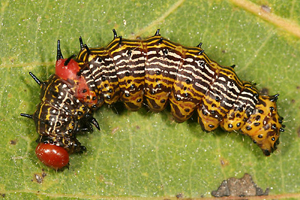Leaf Feeders
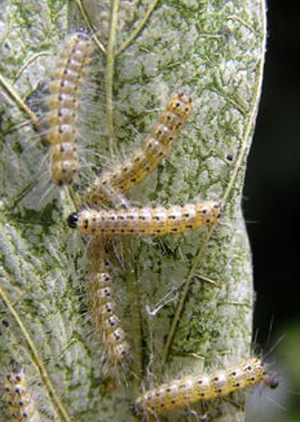
Milan Zubrik, Forest Research Institute - Slovakia, Bugwood.org
Fall webworms are small hairy white caterpillars that live communally in thin silken webs at the ends of branches. They may leave the tent to feed individually as they get larger. While the webbing is unsightly, feeding damage is usually limited to limbs around the tent. Large established trees are not seriously affected by small to moderate infestations. The larval stage feeds for 4 to 8 weeks and may be found on a variety of hardwoods. The first generation occurs in late May and early June, the second generation is usually larger and active from July through September. For more information, see Entfact 424.
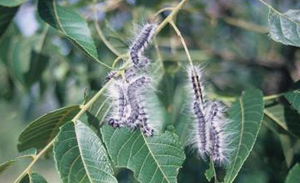
Ward Upham, Kansas State University, Bugwood.org
Walnut caterpillars are black and covered with long gray to white hairs. Clusters of eggs are laid on leaves in June so there can be groups of caterpillars on a tree. They feed mainly during June and July and can defoliate small to medium-sized trees. Two or more years of heavy foliage loss can severely stress or kill trees. Mature larvae drop to the ground and wander in search of a place to pupate and transform to the adult or moth stage. There can be two generations during a season. These insects will feed on butternut, hickory, and pecan.
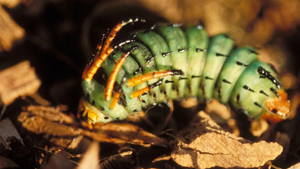
Daniel Herms, The Ohio State University, Bugwood.org
Hickory horned devils are impressive pea green to blue green caterpillars that are 4 to 5 inches long when full grown. They have two pairs of yellow to orange curved horns just behind the head and paired rows of spines down the back. These caterpillars will lash around when disturbed but are not dangerous. HHD are present from July to September. They spend the winter as pupae in the soil. These caterpillars eat a lot of leaf tissue but only pose a threat to small trees. They are rarely numerous enough to defoliate medium to large trees. HHD can feed on butternut, ash, sweet gum, and persimmon. For more information, see Entfact 008.
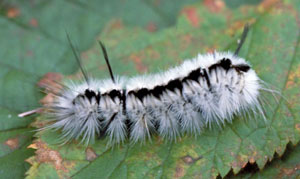
John Ghent, John Ghent, Bugwood.org
The caterpillar stage of the Hickory tussock moth feeds from July to September. Similar to other tussock moths, the hickory tussock has a hairy appearance and is black and white in color. They begin by feeding in groups before moving apart to find leaves. This caterpillar does pose a "stinging" hazard as contact with the hairs may induce a rash on susceptible people.
At its largest, the Redhumped caterpillar is 1-1.5 inches long. The head and first abdominal segment are red, the rest of the body is yellow with black and white stripes. Black tubercles extend from the back. These caterpillars initially feed as a group on a single leaf, skeletonizing it, and use a collective warning display to ward off predators. As they grow, they will spread out as individuals and consume entire leaves. Mature larvae overwinter in the soil and pupate in the spring. Adults fly from June till July and caterpillars feed July to September.
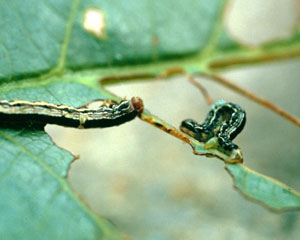
A. Steven Munson, USDA Forest Service, Bugwood.org
Fall cankerworm is a looper caterpillar that can vary from light green with yellow stripes to green with a dark stripe down the back. Overwintering masses of about 100 eggs hatch in later April or early May; small caterpillars chew small holes in young leaves at branch tips. Larger loopers leave only the midrib and major veins. Fall cankerworms are about an inch long when full grown. Mature larvae descend from trees on silk threads to pupate in the soil. They emerge as adults during periods of freezing temperatures to mate and lay eggs on host plants. There is one generation each year.
Sap Feeders
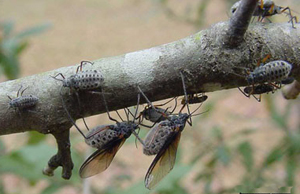
Herbert A. 'Joe' Pase III, Texas A&M Forest Service, Bugwood.org
Giant bark aphid is the largest aphid in North America. This sap feeder can live on several tree species. Winged forms disperse from tree to tree. Wingless aphids occur in large colonies. These aphids produce a large amount of sticky liquid waste, honeydew, which drips onto objects below. Feeding by large numbers of these aphids can damage or kill small twigs. They are eaten by lady beetles and other predators.
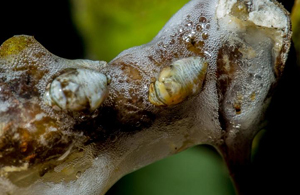
Bill Ravlin, Michigan State University, Bugwood.org
Spittlebugs are small, sap-feeding insects that live in white, foamy masses resembling spit on buds, tender shoots, or nutlets. The liquid provides a high humidity environment and may give protection from natural enemies. Spittlebug adults, which resemble light brown leafhoppers, are active about mid-May.
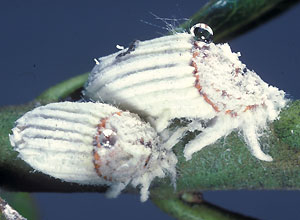
Sturgis McKeever, Georgia Southern University, Bugwood.org
Cottony cushion scale is an invasive scale species that can be found feeding on the sap of numerous species of plants. Adult females are orange-brown but coated with white wax and will have a long, fluted egg sac attached to the body. This can contain up to 1,000 eggs. After hatching, the nymphs (which are red with dark antennae and legs) will seek a suitable space for feeding. Nymphal feeding on leaves can cause extensive damage and honeydew/black sooty mold will accumulate as the population builds.
Borers
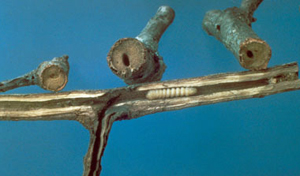
James Solomon, USDA Forest Service, Bugwood.org
Twig pruners are the larvae of small beetles that tunnel in twigs and small branches. Female beetles lay their eggs about the time of bud break in the spring. Eggs are laid in small holes which are chewed into the bark. The larvae that hatch from these eggs bore into and tunnel toward the base of twigs. In late summer, they chew concentric circles outward toward the bark then move toward the tip. The twig eventually snaps and falls to the ground. The larva pupates in the fallen twig and emerges as an adult in the spring. Collecting and destroying fallen twigs can help to reduce infestations.
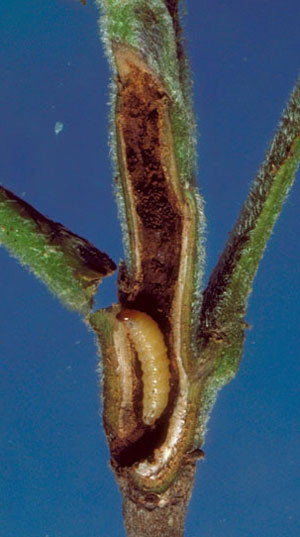
James Solomon, USDA Forest Service, Bugwood.org
Hickory shoot curculio larvae are legless grubs that develop in the new shoots. During bud break, females will lay their eggs new the base of leaf axils. After hatching, the larvae will develop over the summer before emerging to find overwintering spots. Their damage can induce early leaf drop and flagging throughout the branches of infested trees. For more information, see this Kentucky Pest News article.
Galls
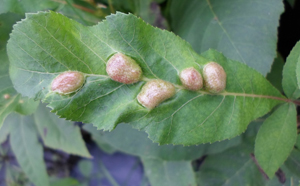
Jonas Janner Hamann, Universidade Federal de Santa Maria (UFSM), Bugwood.org
The pecan phylloxera is an aphid-like insect that produces galls on new pecan growth. Leaves, twigs and nuts may be affected. They spend the winter as eggs in bark crevices. The eggs hatch in the spring; the tiny nymphs feed on tender young growth, secreting a substance which stimulates plant tissues to develop into galls. When the nymph matures, eggs are deposited in the gall. Young nymphs develop within the gall. The gall splits in several weeks liberating them. Several generations are produced each year, as long as there is fresh young growth on the tree. For more information, see Entfact 210.
Nut Feeders
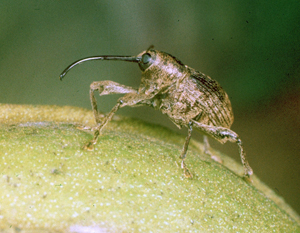
Clemson University - USDA Cooperative Extension Slide Series, Bugwood.org
The pecan weevil is a small beetle with a long snout. It emerges from the ground in late August, about the time nuts begin to harden, usually following a heavy rain. After the nut kernels have hardened, the female uses her long snout to chew a hole in the side of the nut and deposits her egg in little pockets in the nut. Creamy white grubs with reddish brown heads hatch and feed inside the nuts during the fall. They leave the nut in late fall or early winter, fall to the ground, and pupate in the soil. For more information, see Entfact 206.
